Development of Active Centrifugal Pump for Microfluidic CD Platforms
Abstract
1. Introduction
2. Design and Operational Concept
2.1. Microfluidic Centrifugal Pump
2.2. Microfluidic CD Design and Fabrication
3. Results and Discussion
3.1. Pump Performance While the Microfluidic CD Is Stationary
3.2. Pumping Balance Head Points
3.3. Flow Reciprocation by Continuous Pumping
3.4. Bidirectional Pumping
3.5. Flow-Switch Pumping
4. Conclusions
Supplementary Materials
Author Contributions
Funding
Acknowledgments
Conflicts of Interest
References
- Khanfar, M.; Abu Eisheh, N.; Al-Ghussain, L.; Al-Halhouli, A. Lab on a chip for the colorimetric determination of nitrite in processed meat products in the Jordanian market. Micromachines 2019, 10, 36. [Google Scholar] [CrossRef] [PubMed]
- Al-Halhouli, A.; Alshare, A.; Mohsen, M.; Matar, M.; Dietzel, A.; Büttgenbach, S. Passive micromixers with interlocking semi-circle and omega-shaped modules: Experiments and simulations. Micromachines 2015, 6, 953–968. [Google Scholar] [CrossRef]
- Warkiani, M.E.; Tay, A.K.P.; Khoo, B.L.; Xiaofeng, X.; Han, J.; Lim, C.T. Malaria detection using inertial microfluidics. Lab Chip 2015, 15, 1101–1109. [Google Scholar] [CrossRef] [PubMed]
- Madou, M.J.; Lee, J.; Daunert, S.; Lai, S.; Shih, C.H. Design and fabrication of CD-like microfluidic platforms for diagnostics: Polymer-based microfabrication. Biomed. Microdevices 2001, 3, 245–254. [Google Scholar] [CrossRef]
- Khanfar, M.F.; Al-Faqheri, W.; Al-Halhouli, A. Low cost lab on chip for the colorimetric detection of nitrate in mineral water products. Sensors 2017, 17, 2345. [Google Scholar] [CrossRef] [PubMed]
- Matar, M.; Al-Halhouli, A.T.; Dietzel, A.; Büttgenbach, S. Microfabricated centrifugal pump driven by an integrated synchronous micromotor. Microsyst. Technol. 2017, 23, 2475–2483. [Google Scholar] [CrossRef]
- Al-Halhouli, A.T.; Demming, S.; Dietzel, A.; Büttgenbach, S. Design, fabrication, and characterization of a continuous flow micropump system. J. Therm. Sci. Eng. Appl. 2016, 8, 1–6. [Google Scholar] [CrossRef]
- Karimian, S.M.H.; Hasheminasab, S.M.; Arabghahestany, M. Molecular dynamics simulation of stationary and rotating nanotube in uniform liquid argon flow. In Proceedings of the 4th Micro and Nano Flows Conference, London, UK, 7–10 September 2014; pp. 7–10. [Google Scholar]
- Burger, R.; Kurzbuch, D.; Gorkin, R.; Kijanka, G.; Glynn, M.; McDonagh, C.; Ducrée, J. An integrated centrifugo-opto-microfluidic platform for arraying, analysis, identification and manipulation of individual cells. Lab Chip 2015, 15, 378–381. [Google Scholar] [CrossRef]
- Arabghahestani, M.; Karimian, S.M.H. Molecular dynamics simulation of rotating carbon nanotube in uniform liquid argon flow. J. Mol. Liq. 2017, 225, 357–364. [Google Scholar] [CrossRef]
- Shen, F.; Li, X.; Li, P.C.H. Study of flow behaviors on single-cell manipulation and shear stress reduction in microfluidic chips using computational fluid dynamics simulations. Biomicrofluidics 2014, 8, 14109. [Google Scholar] [CrossRef]
- Al-Halhouli, A.; Al-Shishani, G.; Albagdady, A.; Al-Faqheri, W. New generation of spinning systems for robust active mixing on microfluidic CDs: Oil/water emulsion as an evaluation test. RSC Adv. 2018, 8, 26619–26625. [Google Scholar] [CrossRef]
- Al-Faqheri, W.; Thio, T.H.G.; Qasaimeh, M.A.; Dietzel, A.; Madou, M.; Al-Halhouli, A. Particle/cell separation on microfluidic platforms based on centrifugation effect: A review. Microfluid. Nanofluid. 2017, 21, 1–23. [Google Scholar] [CrossRef]
- Aeinehvand, M.M.; Ibrahim, F.; Faqheri, W. Al; Joseph, K.; Madou, M.J. Recent advances in the development of micropumps, microvalves and micromixers and the integration of carbon electrodes on centrifugal microfluidic platforms. Int. J. Nanotechnol. 2018, 15, 53. [Google Scholar] [CrossRef]
- Gorkin, R.; Clime, L.; Madou, M.; Kido, H. Pneumatic pumping in centrifugal microfluidic platforms. Microfluid. Nanofluid. 2010, 9, 541–549. [Google Scholar] [CrossRef]
- Aeinehvand, M.M.; Ibrahim, F.; Harun, S.W.; Al-Faqheri, W.; Thio, T.H.G.; Kazemzadeh, A.; Madou, M. Latex micro-balloon pumping in centrifugal microfluidic platforms. Lab Chip 2014, 14, 988–997. [Google Scholar] [CrossRef]
- Devarenne, S.T.P.; Han, A.; Darwin, S.; Reyes, R.; Reyes, D.R.; Folch, A.; Minhas, H.; Gaitan, M.; Stubbs, J.; Lee, A.; et al. Microfluidic timer for timed valving and pumping in centrifugal microfluidics. Lab Chip 2014, 1381–1388. [Google Scholar]
- Thio, T.H.G.; Ibrahim, F.; Al-Faqheri, W.; Moebius, J.; Khalid, N.S.; Soin, N.; Kahar, M.K.B.A.; Madou, M. Push pull microfluidics on a multi-level 3D CD. Lab Chip 2013, 13, 3199–3209. [Google Scholar] [CrossRef] [PubMed]
- Thio, T.H.G.; Ibrahim, F.; Al-Faqheri, W.; Soin, N.; Bador, M.K.; Madou, M. Sequential push-pull pumping mechanism for washing and evacuation of an immunoassay reaction chamber on a microfluidic CD platform. PLoS ONE 2015, 10, e0121836. [Google Scholar] [CrossRef] [PubMed]
- Al-Faqheri, W.; Ibrahim, F.; Thio, T.H.G.; Aeinehvand, M.M.; Arof, H.; Madou, M. Development of novel passive check valves for the microfluidic CD platform. Sens. Actuators A Phys. 2015, 222, 245–254. [Google Scholar] [CrossRef]
- Abi-Samra, K.; Clime, L.; Kong, L.; Gorkin, R.; Kim, T.H.; Cho, Y.K.; Madou, M. Thermo-pneumatic pumping in centrifugal microfluidic platforms. Microfluid. Nanofluid. 2011, 11, 643–652. [Google Scholar] [CrossRef]
- Kong, M.C.R.; Bouchard, A.P.; Salin, E.D. Displacement pumping of liquids radially inward on centrifugal microfluidic platforms in motion. Micromachines 2012, 3, 1–9. [Google Scholar] [CrossRef]
- Haeberle, S.; Schmitt, N.; Zengerle, R.; Ducrée, J. Centrifugo-magnetic pump for gas-to-liquid sampling. Sens. Actuators A Phys. 2007, 135, 28–33. [Google Scholar] [CrossRef]
- Budynas, R.; Nisbett, J.K. Mechanical Engineering: Shigley’s Mechanical Engineering Design; McGraw-Hill: New York, NY, USA, 2008; ISBN 0-390-76487-6. [Google Scholar]
- Zoval, J.V.; Madou, M.J. Centrifuge-based fluidic platforms. Proc. IEEE 2004, 92, 140–153. [Google Scholar] [CrossRef]
- Chang, Y.-J.; Chen, S.-C.; Hsu, C.-L. Study on microchannel design and burst frequency detection for centrifugal microfluidic system. Adv. Mater. Sci. Eng. 2013, 2013, 1–9. [Google Scholar] [CrossRef]
- Noroozi, Z.; Kido, H.; Peytavi, R.; Nakajima-Sasaki, R.; Jasinskas, A.; Micic, M.; Felgner, P.L.; Madou, M.J. A multiplexed immunoassay system based upon reciprocating centrifugal microfluidics. Rev. Sci. Instrum. 2011, 82, 064303. [Google Scholar] [CrossRef] [PubMed]
- Schäfer, T.; Bieberle, A.; Neumann, M.; Hampel, U. Application of gamma-ray computed tomography for the analysis of gas holdup distributions in centrifugal pumps. Flow Meas. Instrum. 2015, 46, 262–267. [Google Scholar] [CrossRef]
- Zhu, J.; Zhang, H.Q. A review of experiments and modeling of gas-liquid flow in electrical submersible pumps. Energies 2018, 11, 180. [Google Scholar]
- Sin, M.L.Y.; Gao, J.; Liao, J.C.; Wong, P. System Integration - A Major Step toward Lab on a Chip. J. Biol. Eng. 2011, 5, 6. [Google Scholar] [CrossRef]
- Al-Faqheri, W.; Ibrahim, F.; Thio, T.H.G.; Bahari, N.; Arof, H.; Rothan, H.A.; Yusof, R.; Madou, M. Development of a passive liquid valve (PLV) utilizing a pressure equilibrium phenomenon on the centrifugal microfluidic platform. Sensors 2015, 15, 4658–4676. [Google Scholar] [CrossRef]
- Al-Faqheri, W.; Ibrahim, F.; Thio, T.H.G.; Moebius, J.; Joseph, K.; Arof, H.; Madou, M. Vacuum/compression valving (VCV) using parrafin-wax on a centrifugal microfluidic CD platform. PLoS ONE 2013, 8, 2–10. [Google Scholar] [CrossRef]
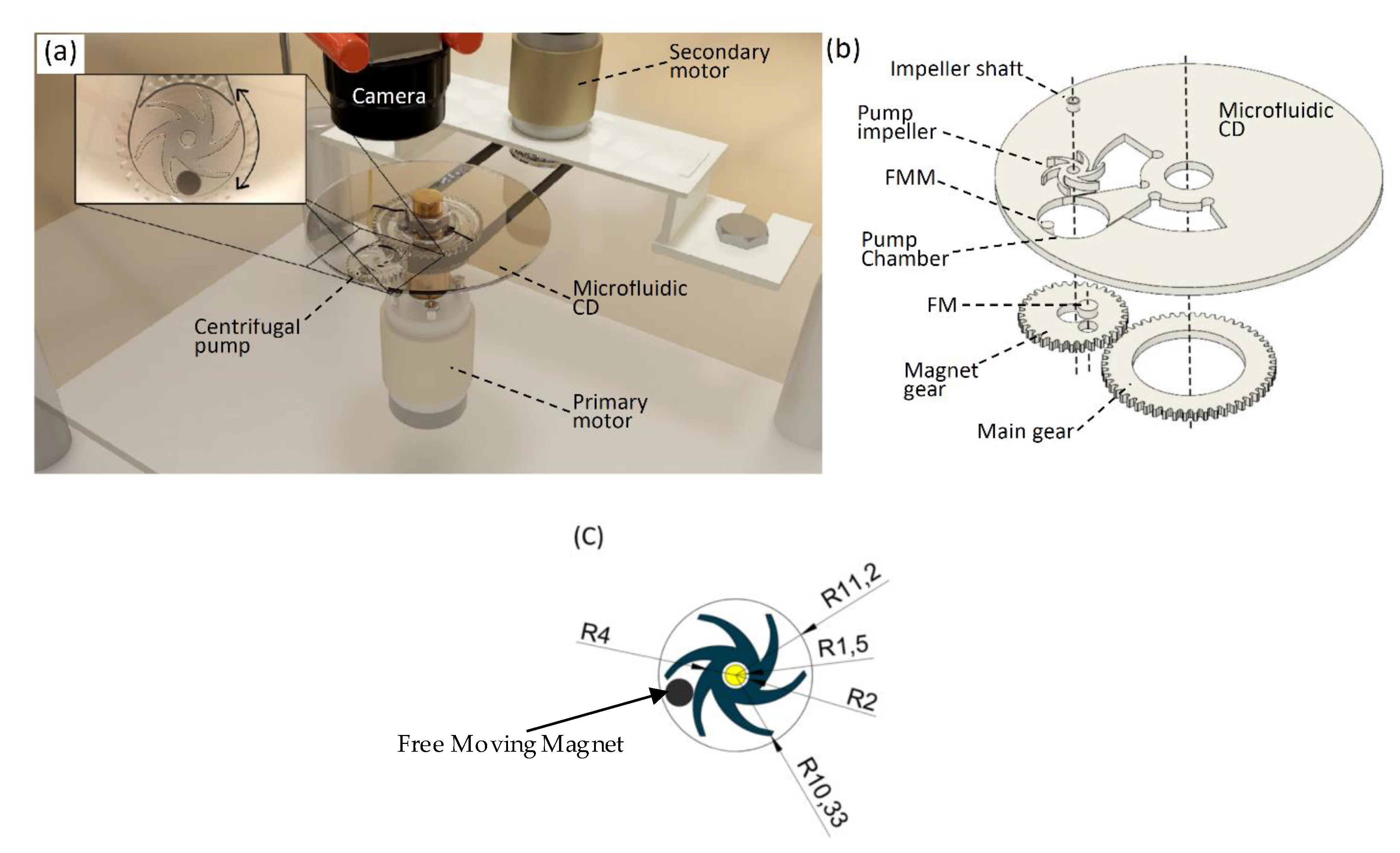
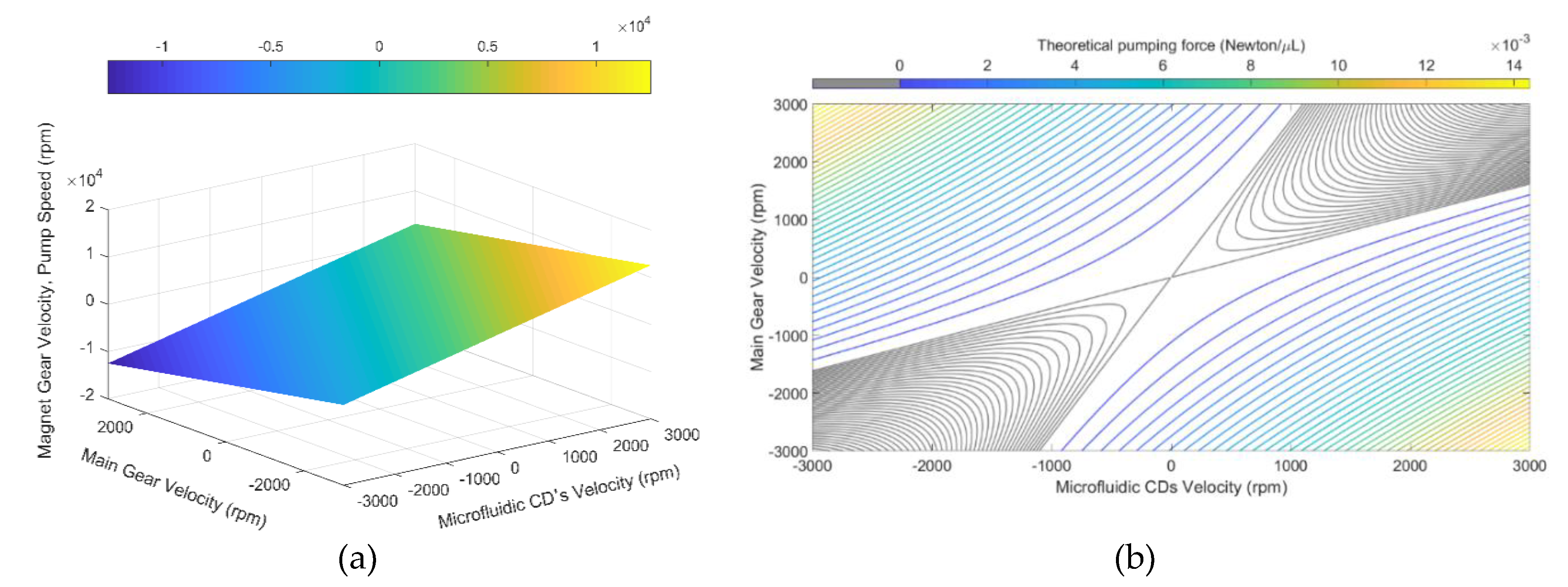
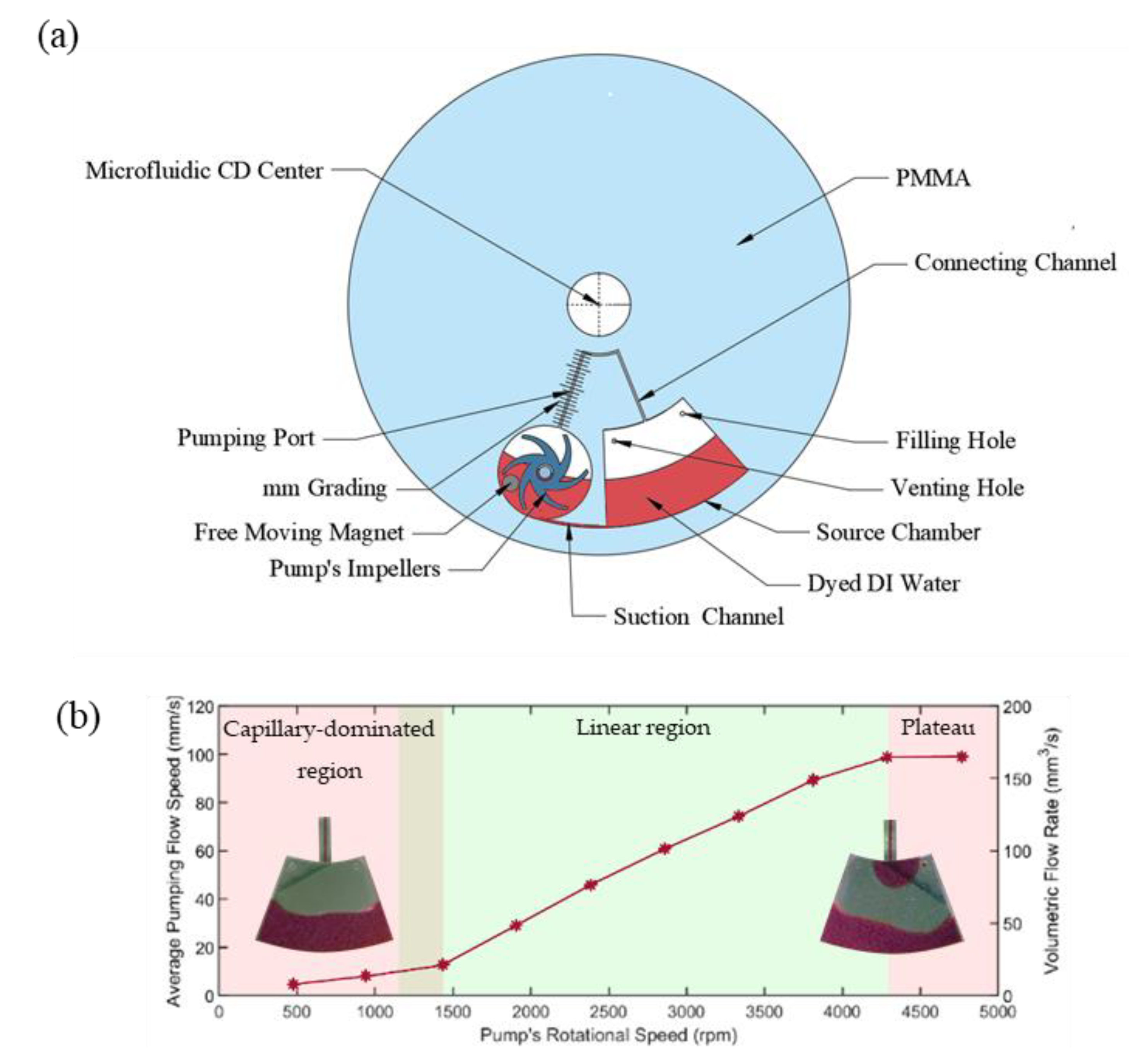


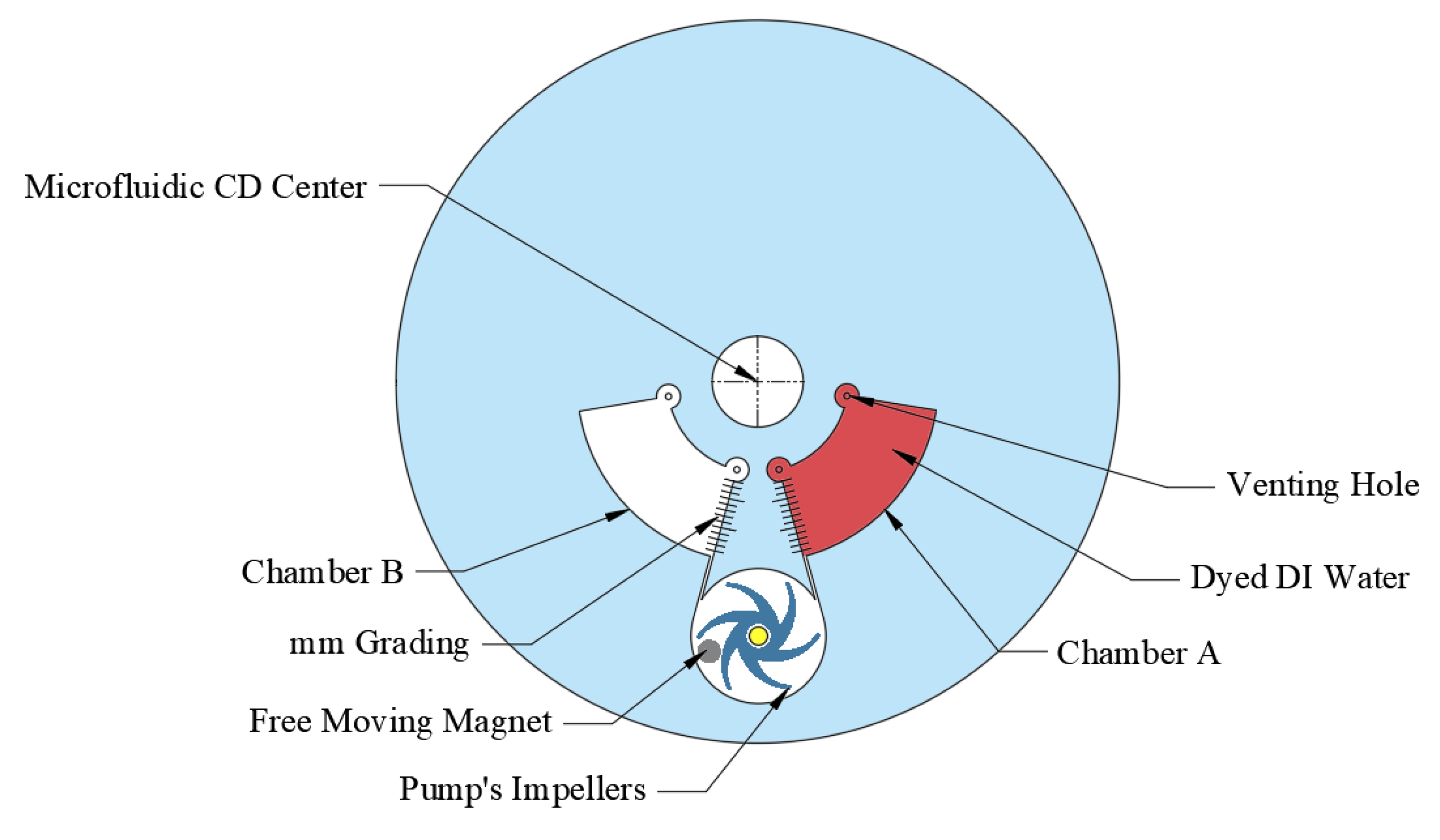

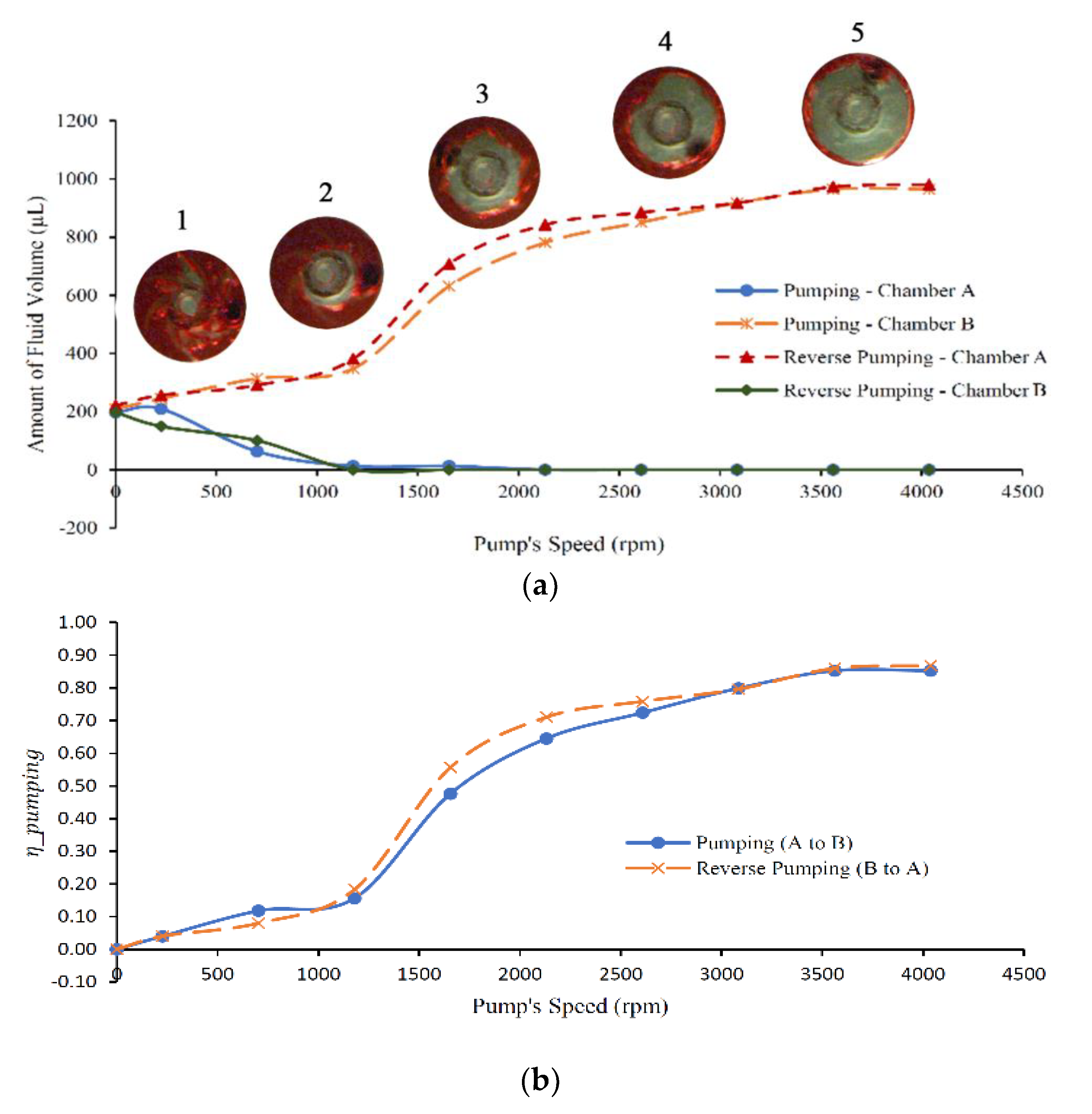
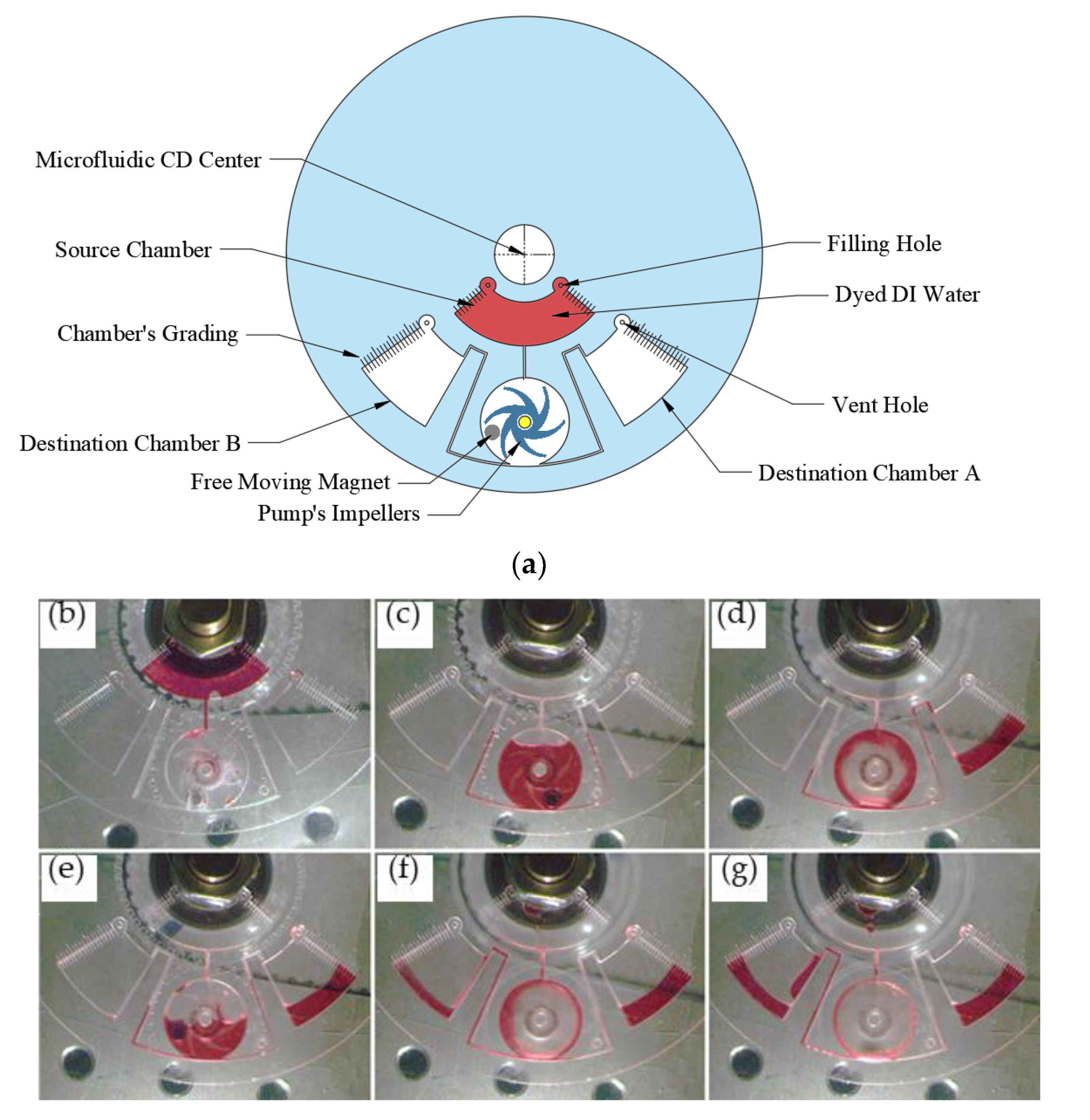
© 2020 by the authors. Licensee MDPI, Basel, Switzerland. This article is an open access article distributed under the terms and conditions of the Creative Commons Attribution (CC BY) license (http://creativecommons.org/licenses/by/4.0/).
Share and Cite
Al-Halhouli, A.; El Far, B.; Albagdady, A.; Al-Faqheri, W. Development of Active Centrifugal Pump for Microfluidic CD Platforms. Micromachines 2020, 11, 140. https://doi.org/10.3390/mi11020140
Al-Halhouli A, El Far B, Albagdady A, Al-Faqheri W. Development of Active Centrifugal Pump for Microfluidic CD Platforms. Micromachines. 2020; 11(2):140. https://doi.org/10.3390/mi11020140
Chicago/Turabian StyleAl-Halhouli, Ala’aldeen, Baha El Far, Ahmed Albagdady, and Wisam Al-Faqheri. 2020. "Development of Active Centrifugal Pump for Microfluidic CD Platforms" Micromachines 11, no. 2: 140. https://doi.org/10.3390/mi11020140
APA StyleAl-Halhouli, A., El Far, B., Albagdady, A., & Al-Faqheri, W. (2020). Development of Active Centrifugal Pump for Microfluidic CD Platforms. Micromachines, 11(2), 140. https://doi.org/10.3390/mi11020140





